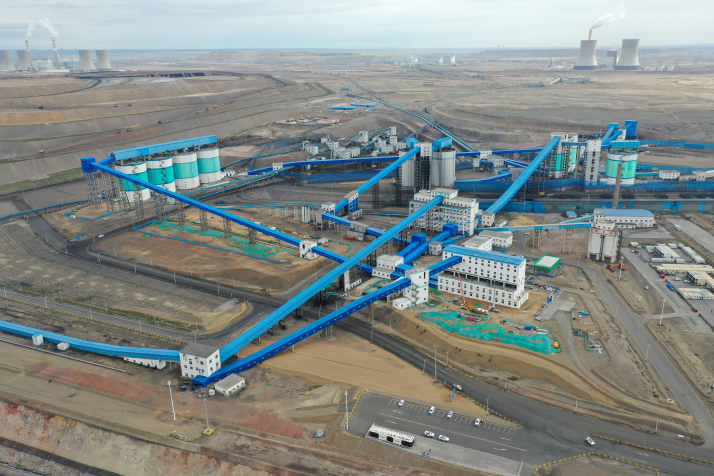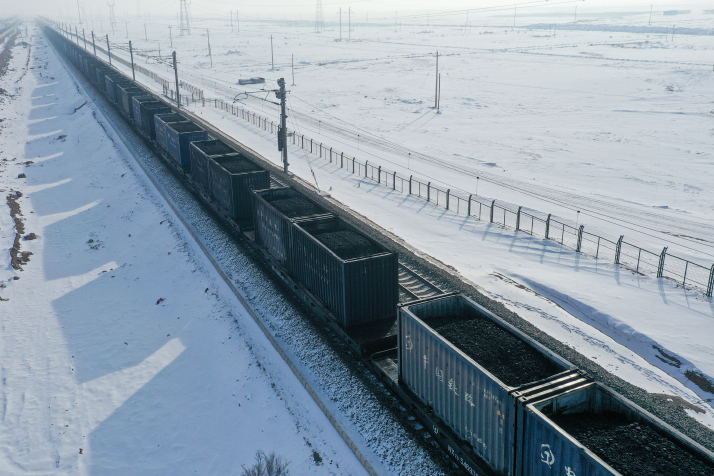| Xinjiang Today |
| Powered for progress | |
|
|
 A view of the Zhundong open-pit coal mine of Xinjiang Zhundong Energy Co. Ltd. on September 26, 2024 (XINHUA)
With its abundant coal resources, Xinjiang plays a pivotal role in China's national energy security strategy, which aims to revolutionize consumption, supply, technology and institutions, while strengthening all-round international cooperation.
Building clean and efficient coal processing and utilization industrial clusters is a crucial effort for Xinjiang to serve that strategy, and also an effective path to achieve transformation of its local economy and green development. Rare resources and policy advantages Xinjiang has over 2 trillion tons of coal resources, accounting for approximately 40 percent of the country's total. It has four major coalfields—Junggar, Turpan-Hami, Ili and Kubai—all core areas of resource concentration. Two 100-million-ton coal production bases have been established in Zhundong in Changji Hui Autonomous Prefecture and Hami Prefecture. In 2024, the region's raw coal output crossed 500 million tons, up 17.5 percent over the previous year. The rate of increase was the highest among major coal-producing areas in the country for four consecutive years. Xinjiang's coal resources are not only vast but also of excellent quality, providing a solid foundation to build up industrial clusters. For example, the oil-rich coal in Hami has an average oil content of over 10 percent, making it an ideal raw material for coal-to-oil conversion. Zhundong coal has low ash, phosphorus and sulfur content, as well as high volatile matter, making it suitable for producing coal gas. A series of recent policies have injected strong momentum into the local industry. The Central Government has positioned Xinjiang as a national base for large-scale oil and gas production and storage, for coal production, thermal power generation and coal chemical industry, and for wind power generation, as well as the national energy and resources corridor. Xinjiang has responded by issuing documents that clarify the goals, tasks and measures for their implementation, providing policy guarantees for building such industrial clusters. Leveraging these resource and policy advantages, Xinjiang is poised to make a substantial contribution to national energy security. It will enhance the national self-sufficiency in oil and gas, reduce dependence on imports and ensure stable energy supplies. At the same time, the related industrial clusters will boost Xinjiang's high-quality economic development, drive the growth of related industries, generate job opportunities, and contribute to regional economic prosperity, helping to maintain long-term social stability in Xinjiang.  A freight train loaded with coal runs on a railroad in Xinjiang on January 21 (XINHUA)
Driving industrial upgrading Xinjiang has focused on the technological areas of clean and efficient coal production, processing and utilization, carried out scientific research and development (R&D), and achieved breakthroughs in multiple aspects. Environment-friendly methods such as water-preserved mining, backfilling mining and pillarless mining have been promoted, thereby reducing the ecological damage in the production process. Water-preserved mining is designed to minimize or mitigate the impact of mining activities on water resources, particularly in areas with limited water availability. Backfilling mining ensures that the voids left after ore extraction are filled to enhance mine stability, improve safety, and mitigate environmental impacts. In pillarless mining, coal is extracted without leaving behind the traditional pillars of supporting material. In the coal power sector, the clean and low-carbon level of coal power has been improved through renovations of generators to save energy, reduce emissions and increase operational flexibility. In the coal chemical sector, China's first self-developed coal-based methanol-acetic acid to methyl methacrylate production unit has been successfully operated in Xinjiang, breaking the technological monopoly of Western countries. Zhundong's coal-to-olefins project with an annual capacity of 800,000 tons, which utilizes homegrown technologies, has achieved comprehensive energy consumption levels for olefin products exceeding industry benchmarks. Such breakthroughs have propelled Xinjiang's clean and efficient coal utilization toward high-end solutions, enhancing its core competitiveness. The region has established several platforms to strengthen innovation capabilities. The Xinjiang University State Key Laboratory of Chemistry and Utilization of Carbon-Based Energy Resources and the Tianshan Laboratory have been constructed, providing robust support for the R&D of clean and efficient processing and utilization technologies in coal mining areas. Xinjiang has strengthened cooperation with domestic and foreign universities and research institutions, introduced advanced technologies and high-caliber professionals, and promoted technological exchange and the transformation of innovative achievements. Full-chain advancement The progress made cannot be separated from the coordinated development of the various segments in the clean and efficient coal utilization sector and related industries. Xinjiang is building an industrial pattern integrating coal, power, chemistry and new energy. In core sectors such as coal mining, power and chemicals, collaboration and coordination among upstream and downstream enterprises have been strengthened to achieve efficient resource allocation and recycling. It promotes the optimal combination and coordinated development of coal and coal power, as well as coal power and renewable energy. Through capital integration, mergers and acquisitions, and integrated operations, it is improving comprehensive energy utilization efficiency. At the same time, the region promotes the integration of the clean and efficient coal utilization sector with related industries, so as to boost new materials, equipment manufacturing and other areas, forming a mutually reinforcing and coordinated development landscape. This industrial synergy model not only improves resource utilization efficiency but also extends the industrial chain, enhancing added value and comprehensive benefits.  The intelligent cloud control center of the Zhundong open-pit coal mine on September 26, 2024 (XINHUA)
A green path During this process, Xinjiang is also prioritizing ecological and environmental protection, adhering to a green and low-carbon path. By enforcing strict control including red lines for environmental protection, minimum standards for environmental quality, and ceilings on resource utilization, Xinjiang has strengthened environmental impact monitoring of the entire process of coal mining, processing, storage, transportation and utilization. In the coal mining sector, green mining technologies have been promoted to reduce damage to land, water resources and the ecological environment. In the coal power and coal chemical sectors, investments in environmental protection facilities have been increased, and comprehensive treatment and recycling of waste gas, wastewater and waste residue has been advanced. To achieve the energy-saving and emission-reduction goals, the region is promoting clean and efficient coal utilization together with developing new energy. Leveraging the abundant wind and solar resources in Zhundong and Hami, Xinjiang supports the construction of new energy projects within or near coal chemical enterprises, replacing thermal power with green electricity to reduce coal consumption. Green hydrogen produced through electrolysis is used to supplement chemical raw materials, promoting the transition from gray hydrogen produced by using fossil fuels, the replacement of coal, and the use of green hydrogen to offset carbon emissions. Besides, the region is advancing the carbon capture, utilization and storage industries. Making full use of its natural geological conditions such as oil reservoirs and saline aquifers, Xinjiang is conducting large-scale engineering demonstrations to promote the capture, utilization and storage of carbon dioxide, contributing its strength to meet the nation's goal of peaking carbon emissions before 2030 and attaining carbon neutrality before 2060. The future of such industrial clusters in Xinjiang holds great promise. Its coal resource utilization will be enhanced, with intelligent coal mine construction achieving full coverage, and the renovation of coal-fired power generators will be accelerated. Mechanisms for clean and efficient coal processing and utilization will become more robust, and the integration of coal, coal power, coal chemistry and renewable energy will deepen. Xinjiang is on track to become China's largest energy security base for coal oil and coal gas, plus modern coal chemical engineering. The author is an associate professor at the Xinjiang Institute of Engineering. This article was first published in Xinjiang Daily Comments to yanwei@cicgamericas.com |
|
||||||||||||||||||||||||||||
|